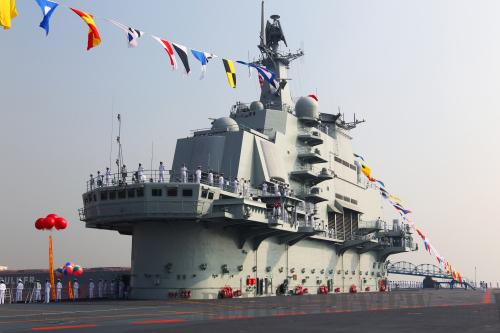|
 |
|
BIG TIME: China's first aircraft carrier, the Liaoning, is delivered and commissioned to the PLA Navy at a ceremony at a naval base in Dalian, Liaoning Province, on September 25 (ZHA CHUNMING) |
The training of pilots is especially challenging, Yin said.
The Liaoning is reportedly capable of carrying around 30 fixed-wing fighters and helicopters.
"Generally, the training cycle of a carrier-borne aircraft pilot lasts for three years. The pilot then has to go through a three-year residency period on the aircraft carrier, plus one more year of training on the carrier before being permitted to fly alone," Yin said.
Not a threat
When the Chinese Ministry of National Defense first confirmed the country's aircraft carrier program last July, spokesman Geng Yansheng said, "The pursuit of an aircraft carrier program will not change the navy's inshore defense strategy."
Geng told reporters at a press conference that the aircraft carrier platform will be used for "scientific research, experiments and training."
Yang reiterated at the September 27 press conference that the Liaoning will be used to conduct scientific experiments and military training.
"China adheres to the path of peaceful development, sticks to the independent foreign policy of peace and pursues a defensive national policy," he said, adding that the development of the aircraft carrier is to protect national security.
"As a weapon, an aircraft carrier can be used for both defense and offense, and it can also be used for humanitarian purposes," said Fang Bing, an associate professor at the NDU.
Fang said he did not believe that the commissioning of the Liaoning was directly related to China's current territorial dispute with Japan over the Diaoyu Islands in the East China Sea. But he warned that China has zero tolerance for foreign infringement of the country's territorial waters, with or without an aircraft carrier.
"In dealing with the territorial and maritime right disputes with some neighboring countries, China has remained committed to solving the problems through diplomatic channels and negotiations, and opposes the use of force or the threat of force. China's sincerity is well known and should not be doubted," said Yang Yi, a rear admiral and former dire ctor of the Institute for Strategic Studies at the NDU, in an article in China Daily.
In order to counter claims that its new aircraft carrier is a threat, Yang said that the country should not only continue to make clear its strategies and policies, but also take practical steps to convince the world that with the development of its military strength, especially the strengthening of its navy, China will enhance its role as a defender of regional stability and world peace.
The Liaoning
- Overall Length: > 300 meters
- Beam: >70 meters
- Displacement: >50,000 tons (standard)
- Crew number: >1,000
- Holding capacity: Fixed-wing fighters and helicopters
- Captain: Senior Captain Zhang Zheng
- Political commissar: Senior Captain Mei Wen
(Source: PLA Daily)
The PLA Navy
- The PLA Navy was founded in 1949, with two fleets made up of 20 poorly equipped vessels. Four years later, China purchased four advanced ships from the Soviet Union. Over the next two decades, they became the PLA Navy's most powerful surface ships.
- The 1970s saw the PLA Navy move away from importing and imitating other countries' ships to designing and producing vessels on its own. China has developed three generations of home-produced surface ships since then.
- Since 2005, the PLA Navy has entered an era of rapid expansion. It is now well armed with hundreds of class-three or higher combat vessels.
- The PLA Navy now encompasses the East China Sea, North China Sea and South China Sea fleets.
(Source: CNTV)
Email us at: yaobin@bjreview.com | 